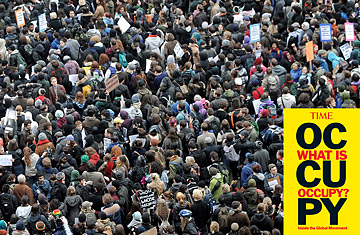
Occupy Wall Street protesters gather in New York City's Union Square during a "Day of Action" on Nov. 17, 2011
(2 of 2)
Keeping It Legal (Mostly)
Even a group inspired by anarchists needs lawyers — a lot of them. By November, more than 1,200 protesters had been arrested in New York City alone. Early on, the National Lawyers Guild, a liberal advocacy organization, started a working group of lawyers to deal specifically with Occupy Wall Street. The guild has sent lawyers, identified by the special green hats they wear, to marches and rallies to witness arrests and take down names of those who go to jail. The guild runs a hot line that family members can call to get information. Guild lawyers have also represented many of the protesters in court, the vast majority of whom have decided to take their cases to trial rather than plea.
Some of Occupy's most basic needs have produced legal battles, notably the necessity for portable toilets at Zuccotti Park. When police refused to allow them, lawyer Christopher Dunn of the New York Civil Liberties Union advised the group that it had to apply for a permit from the city agency that regulates street fairs. After much legal wrangling, the city finally agreed to a plan. Dunn acknowledges that representing a leaderless group has been a challenge. "It's not like you know for sure what they are going to do," said Dunn. "It makes it hard to negotiate with the other side."
Mobilizing the Marches
Occupy Wall Streeters may have no leaders, but from the beginning, the direct-action committee has had more sway over the group than others. In the argot of Occupy Wall Street, a march or protest is called a direct action. Unlike most other decisions that go to the general assembly, the direct-action committee has the power to pick and plan its event. Among the preparations the committee makes for marches is holding training sessions to teach members how to avoid violent confrontations with police and citizens.
Longenecker, who has been on the direct-action committee since the protest began, admits that Occupy has made mistakes. In the first Brooklyn Bridge march, Longenecker says, he and others who planned the march wanted to give some of the protesters the ability to block the roadway and ultimately get arrested, if that was what they chose. A group of many hundreds went onto the roadway, many of them perhaps unsuspecting of their likely fate. At least 700, possibly more, were arrested that day, many more than planned. "We learned from it," says Longenecker. "But that march, our mistake, also put us on the map."
Creating a Culture
When planning a protest to denounce the growing economic divide between the richest Americans and the rest of us, you might not expect an arts and culture committee to be high on your list of priorities. But it was for Occupy Wall Street, which has roots in art. A group of artists called 16Beaver, named for the address of a downtown studio where they regularly meet, had long discussed occupying a public space as a form of performance art and were some of the first people to sign on to the movement. Since then, cultural creativity has seemed to spring naturally from Occupy Wall Street: regular poetry readings in Zuccotti Park, giant Halloween puppets of the Statue of liberty and Wall Street's Charging Bull.
Most famous of all were the protest signs. In October, on the night before the mayor first threatened to remove protesters from the park, Jez Bold, Occupy Wall Street's unofficial curator, was busy packing up the signs to protect them. "Some of these are truly beautiful," said Bold. The People's Library, too, was an inspired creation. Situated in a corner of Zuccotti Park, it contained more than 5,000 donated volumes, including books from such leftist authors as Howard Zinn, Noam Chomsky and Naomi Klein, all organized according to ISBN. Said Zachary Loeb, one of a dozen librarians who volunteered to care for the books: "Information matters. We are feeding people's minds." The books were confiscated when police cleared the park in November, and many were lost, but like so much of what happened in the early days, the People's Library is now a permanent part of Occupy's colorful history.
The question is whether Occupy Wall Street, which is likely to become more specifically goal-oriented now that it can no longer count its success in numbers of days in Zuccotti Park and similar spaces around the country, will start developing the kind of organization that it has so emphatically rejected so far. Dedicated office space alone is a sign that the group is becoming more like other traditional activist groups. Already, the emergence of a high-level committee has caused grumbling in the ranks.
Can the movement stay true to its grass roots and still change the country's direction? Sounds like a good topic for a general assembly.
Excerpted from What Is Occupy? Inside the Global Movement, a new book from the editors of TIME. To buy a copy as an e-book or a paperback, go to time.com/occupybook.
